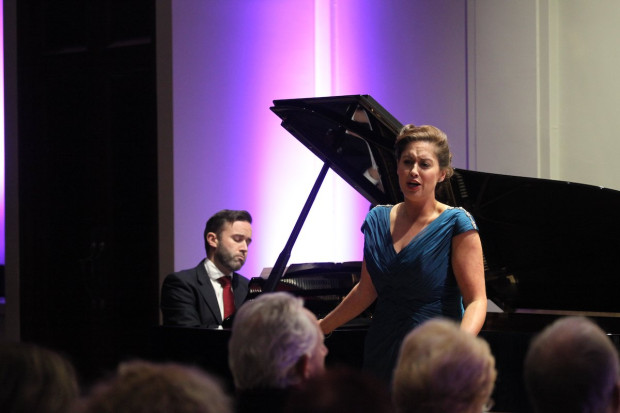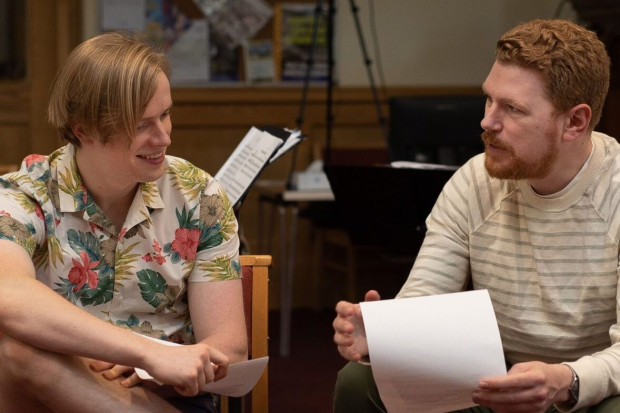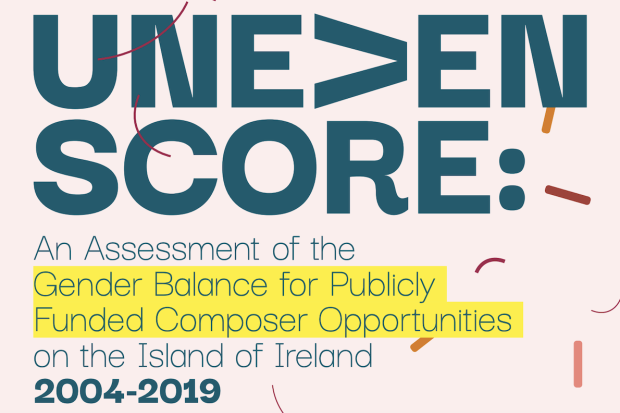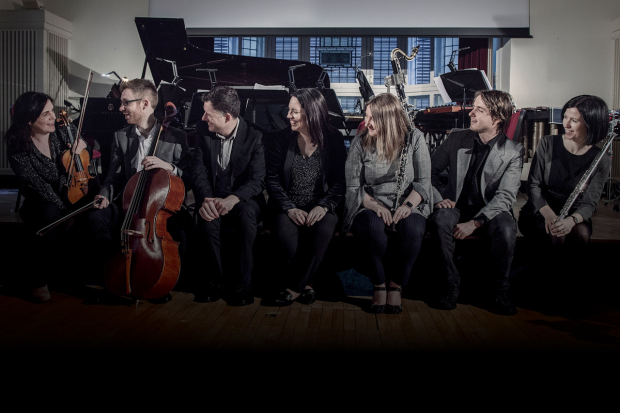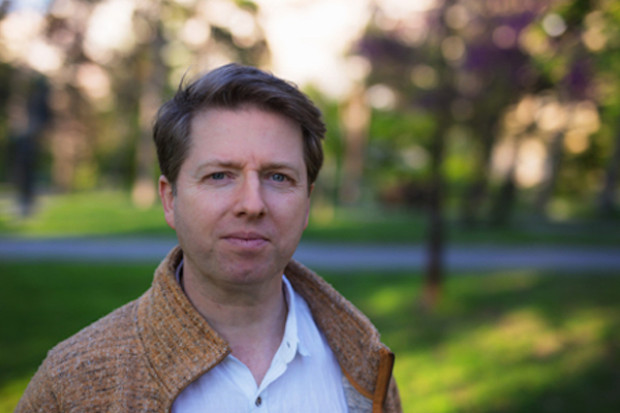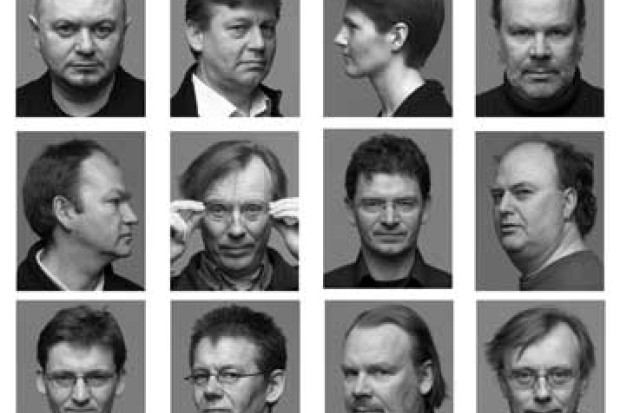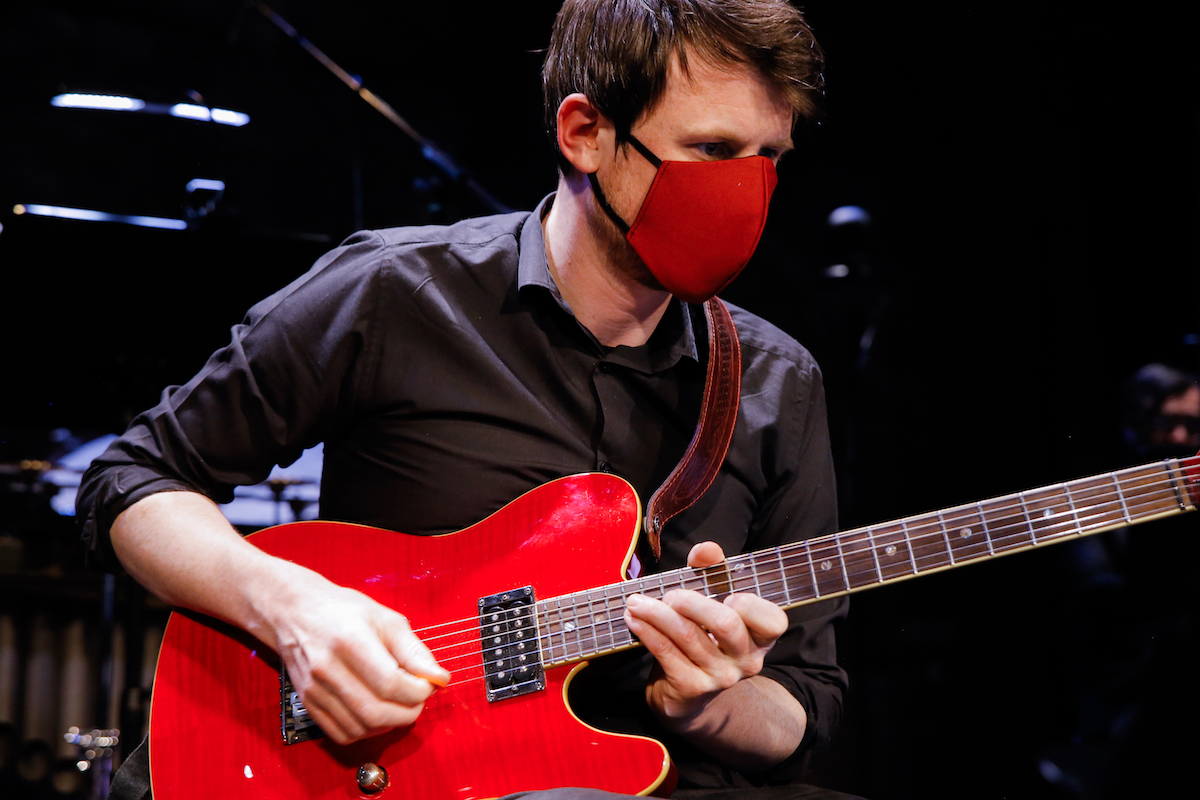
Barry O'Halpin performing in his composition 'Wingform' with Crash Ensemble at New Music Dublin (Photo: Molly Keane)
Music Worth Making
The perennial fear that many in the new music community always have in the back of their minds is that New Music Dublin will one day suffer the fate of previous new music festivals and be wound up suddenly without notice or explanation. If there was one year in which this would have seemed more likely to happen, it was this year with the pandemic making the prospect of live music all but impossible. Therefore, the brave decision to go ahead with this year’s festival when a cancellation might have been tempting seemed to set down a marker of intent that this festival is in it for the long haul. Addressing the wisdom of holding this year’s festival in spite of all the restrictions, festival director John Harris reflected on the NMD website:
Is new music really that fragile? Do we have to wait until the wind is in favour, the tide is rising, the stars correctly aligned? Surely if music is worth making, it is worth making despite – or perhaps because of – the need for it to be re-thought, re-worked, re-made for our new times. Because the times will surely change again, and we will as surely have to change with them.
These are quite elegant thoughts indeed and perhaps the most significant thing about this year’s festival is simply the fact that it went ahead at all, continuing the sense of momentum that has been gradually building with the last two very successful festivals in 2019 and 2020.
While bad weather had previously plagued the festival with heavy snow forcing the cancellation of the 2018 event, this year the problem was of a different order in that the festival happened to coincide with the best weekend of sunshine so far this year, making the prospect of sitting inside to watch three days of streamed performances an experience only for the seriously committed. Wisely, the festival organisers had seen to it that each of the performances were recorded directly onto YouTube immediately after the live event so that less fanatically inclined enthusiasts could watch (and can still until 10 May) select concerts at their leisure.
Nevertheless, some people did stick it out for the entire festival and this review will discuss the highs and lows of this year’s event with a particular focus on the world premieres that took place over the course of the weekend.
Day 1 – Friday 23 April 2021
1pm: Grounded
Reflecting concerns about climate change – something that is becoming a very definite theme in new music – the opening concert of the festival titled ‘Grounded’ was originally inspired by the example of the British soprano Juliet Fraser, who has forsworn air travel completely, choosing to travel only by land and sea. The concert featured music for harp (Richard Allen) and voice (Michelle O’Rourke) with two world premieres by Deirdre Gribbin and Ed Bennett.
For her piece, Gribbin chose to set some of her own poetry that reflected on the destruction being inflicted on the planet by human activity. The setting was quite traditional in that the harp remained mostly in an accompanimental role throughout with short repetitive figures providing a melancholic, reflective atmosphere to the broad, free-flowing vocal line. Occasionally, flashes of urgency broke through, however, such as in the second song where the imagery of a burning earth was depicted with glissando flourishes on the harp and a dramatic climax in the vocal line.
While the brief for this concert was hatched before the pandemic, the term ‘grounded’ subsequently came to signify a rather different meaning, with everybody finding themselves literally ‘grounded’ with our movements greatly curtailed. This somewhat changed the nature of the theme for Bennett, who chose to set some fragments of text from a journal that he had kept during the past year. Much of the piece was an exploration of delicate combinations of harmonic colour and timbre between the voice, the harp and a synthesizer (played by O’Rourke). The simple nature of these reflections – ‘We are well’, ‘We couldn’t find each other’, ‘I know I can do better’ – were intensified either through long sustained notes or short, very simple phrases that locked into similarly minimalist material on the harp and synthesizer.
The purity and perfect intonation of O’Rourke’s voice and Allen’s sensitive harp playing resulted in excellent performances of these very contrasting settings.
2.30pm, 3.30pm and 4.30pm: Evlana – Constellations 1, 2 and 3
Friday afternoon was given over to three back-to-back concerts by the Evlana ensemble that featured two world premieres – by John McLachlan and Jane Deasy – alongside a range of works by established Irish composers.
John McLachlan’s piece – entitled Headland for medium-sized chamber ensemble – began with a series of flourishes that terminated with a resonant piano chord and a trill that appeared in different instrumental permutations as it was repeated. This led into a section that explored sustained sonorities on different pairs of instruments, each of which were introduced by a short staccato attack on the piano or a pizzicato from a string instrument. Much of the central section of the piece consisted of intricate pointillistic textures, sometimes blended with recordings of whale sounds and other electronic material, and, in the final section, a pulsing riff involving most of the ensemble with fast flourishes on the piano brought the piece to its conclusion. While the piece contained plenty of variety, many of these abstract gestures seemed a little jaded and the diverse instrumentation of the ensemble seemed to always stick out, never coalescing into a coherent harmonic or timbral colour.
The second premiere of the afternoon by Deasy in the third concert was titled Supple Music for cello and electronics. Beginning with the low C open string bowed on the bridge that acted as the fundamental, the piece grew into an exploration of the overtone series using live electronics. While the range of sounds produced were quite interesting – especially the grittier, rasping sounds towards the latter stages – and the piece was well constructed, surely this type of one-dimensional spectral study is getting a bit passé at this stage?
Other works that impressed in these concerts were Judith Ring’s Swelt Belly at Dawn for clarinet, violin and cello, which gave a vivid musical impression of the sunrise; there was something very catchy in Amanda Feery’s Kissing the Ground, a swinging dance-like piece for solo viola that recalled the energy of Irish traditional music without referencing it literally; and the powerful clangorous sounds of Gráinne Mulvey’s Sun of Orient Crimson with Excess of Light was easily the most original piece in terms of its soundworld. However, the stand-out work of the three concerts was John Buckley’s Constellations for multiple flutes, a virtuosic tour-de-force for solo performer that built up progressively superimposed layers starting with the bass flute, working upwards to the alto flute, C flute and eventually to the piccolos. Even if you’re are not a fan of relentlessly virtuosic passagework – fun to play, rarely fun to listen to – the sheer compositional skill combined with exceptional playing from Bill Dowdall came together to produce a piece of headlong momentum that convinced even the deeply prejudiced towards the solo woodwind genre.
Ordinarily, three consecutive contemporary music concerts might seem a bit much but Siobhán Cleary’s programming made the pieces flow quite well and the logistics of the various changeovers were clearly well planned.
7pm: RTÉ National Symphony Orchestra – O’Farrell, Buckley and Shaw
The evening concert of the first day was given by the RTÉ NSO, who had commissioned two new works for the festival by Irene Buckley and Anne-Marie O’Farrell, conducted by David Brophy.
Ever since the demise of English Pastoralism, inspirations as pure and simple as the coming of spring have fallen somewhat out of fashion, but this is exactly what Buckley sought to depict with her Awakening, which reflected ‘the wondrous transition from the stasis of winter to the rebirth of spring.’ The piece opened conventionally enough with a unison on the violas and cellos; this gradually spread to the other strings before overlapping sustained notes on the woodwind and brass enriched the texture, producing a glistening, microtonal surface. This provided the canvas for the real highlight of the piece, which was a simple melodic figure passed between the different string instruments starting with violas, and ending on the double basses. For some reason, this idea gave the texture an earthiness and depth that remained in the memory long after the piece was finished and beautifully coincided with the imagery that the piece sought to convey.
Caroline Shaw’s postmodernist Entr’acte, which played on gestures from Haydn, provided some light relief before the second world premiere of the evening, which came in the form of O’Farrell’s Eitilt. If Buckley’s piece took a minimalist approach to material, O’Farrell’s piece packed in an enormous amount over its five movements. Much of this was inspired by Irish traditional music such as the dance-like rhythms of the first movement, the lament in the second or the extended suantraí of the fourth movement. All of these were referenced with a great deal of rhythmic and orchestral invention with multiple soloistic passages for the members of the RTÉ NSO that resulted in a work of great variation and colour.
Day 2 – Saturday 24 April 2021
11am: Gaia
One of the unexpectedly interesting events of last year’s festival was ‘Work in Progress’, a session with flautist Ruth Morley and vocalist Laura Bowler who had commissioned a series of works that set out to explore the nature and impact of climate change. Among the works discussed was a piece by Deirdre McKay that set part of an infamous, rambling speech by Donald Trump on what he perceived as the ineffectiveness of wind farms. Now completed, Postcards from a Fragile Planet uses the Trump speech in the first section, opening with a series of breathy sounds on flute along with vocal effects evoking the circular motion of a windmill. Initially, the effect is quite comic due to the mock-seriousness of the vocal writing. However, this gives way to a slower, more moving section that makes it possible to feel a strange mixture of contempt and pity at such ludicrousness, perhaps not for the former president himself, but for the fate of the planet amidst such political irresponsibility. The second postcard, which set a range of quotations from various figures involved in the fight against climate change, offered quite a sobering juxtaposition and McKay’s writing for both voice and flute was ceaselessly inventive throughout.
1pm: Sonic Adventures for Brass
Saturday’s lunchtime concert was given by the Earlsfort Brass Quintet who were performing from the organ room of the Royal Irish Academy of Music. The concert consisted of six miniature works by Irish composers who had responded to an open call for new works in the weeks leading up to the festival. These will be workshopped and expanded over the next 12 months in order to be ready for next year’s festival. In this sense, therefore, the pieces presented were just ideas in embryo and not finished compositions. Of these, the most promising was Rasp by Anselm McDonnell, which began, as its title suggests, with a rasping glissando on the trombone against an alternating figure in the French horn. This material formed the basis of much of the piece, which was an exploration of the brass instruments’ capacity to produce distinctively gritty sounds. The piece ended just as it seemed to be getting going, which bodes well for next year. The other notable thing about the concert was that it turned out to be one of the shortest I have ever attended, lasting barely over twenty minutes.
3.30pm: Crash Ensemble – This is the Space, Part I
A large part of Crash Ensemble’s sizeable contribution to this year’s NMD consisted of two distinct strands: five world premieres that were part of the group’s annual Free State open commissioning scheme now in its thirteenth edition, while another project, titled [REACTIONS], commissioned composers from different backgrounds to write works for duos within Crash Ensemble. These were accompanied by a series of films by Laura Sheeran that blended imagery from their manuscripts, writings and snippets from the recording sessions. The format of these concerts worked very smoothly as the Free State works were premiered live while the [REACTIONS] were pre-recorded, thus allowing the ensemble to reset seamlessly between pieces. This first Crash concert featured Free State premieres by Darragh Kelly, Gemma Doherty and Ultan O’Brien and [REACTIONS] works by Anselm McDonnell, Seán Ó Dálaigh, Rachael Lavelle and Stephen Shannon.
The concert opened explosively with McDonnell’s Cross-Purposes for B-flat and bass clarinet, cello and tape, which incorporated a number of soundbites from various political figures – Leo Varadkar, Boris Johnson, Dominic Cummings, etc. – that had gained traction or notoriety throughout the pandemic. These were interwoven into an aggressive texture of brutal repetitions, jagged lines and percussive accents that shattered the fake sincerity of the politicians’ utterances.
According to the composer himself, Kelly’s Deep Model Worker joined together two concepts: ‘deep model’, a form of artificial intelligence, and the soviet idea of the ideal ‘model worker’. Some of the material for the piece was arrived at by the composer putting Crash Ensemble’s Crashland album through an AI programme, which in turn learns from the recording and produces new music. While the process sounded fascinating, the musical results were mixed and the piece journeyed through several sections of wildly different material. It also included several spoken sections by the composer himself and video imagery that were presumably intended as an ironic/critical commentary on the perilous position of the modern worker in the midst of so much autonomous technology. For a seven-minute piece, this was perhaps a bit much to take on and the work’s diffuse parts didn’t coalesce convincingly into any forceful message.
One of the more interesting pieces in terms of its soundworld was Ó Dálaigh’s Proximity Studies, an electronic piece that manipulated sounds produced by Crash Ensemble’s percussionist Alex Petcu and guitarist Barry O’Halpin. While it remained relatively low-key throughout, the shimmering metallic sonorities of the piece had a peculiar colour and complexity all of their own that drew in the listener.
After the abstract sonic landscape of Ó Dálaigh’s work, the gently pulsing texture of Doherty’s Middle Distance made for more relaxed listening even if it didn’t push any boundaries in terms of harmony or rhythm, remaining quite diatonic and in the same basic tempo throughout. At the same time, not being radical is hardly a compositional sin and the piece had an undeniable catchiness to it while one of its more interesting features was the use of the harp as a percussion instrument.
For me, the piece of the concert was Lavelle’s this is the space between your hand and mine, which began with a trippy techno beat that provided the background pulse for a high-tension texture of aggressive bowing techniques on cello and double bass. These gradually chilled out into brooding melodic lines between the instruments as the rhythmic pulse dissipated and the piece ended with a short coda of percussive, scratchy extended techniques.
The diatonic melodiousness of O’Brien’s Subtle Inward Migration also made for pleasant listening and in six continuous movements the piece contained a wealth of material. However, in certain sections the blendings between the different instruments of the ensemble didn’t gel particularly well and there was the sense of individual instruments doing their own thing rather than complimenting each other to create a more focused musical impact.
Much more straightforward was Shannon’s One Day, which presented a simple melancholic cell on trombone backed by eighties-style synthesizer chords. A Steve Reich-esque rhythmic figure on vibraphone and xylophone took over before the trombone melody returned accompanied by the percussion figure and the piece wound down from here. Those into ambient music will appreciate this piece.
7pm: RTÉ Concert Orchestra
Saturday evening’s orchestral concert was given over to the music of the Australian/Irish composer Natasa Paulberg, specifically her orchestral piece Atomic Hope. According to the composer, the piece associates ‘the structure of the atom and our current human experience’ in the way that ‘humankind, like the atom, is composed of many unique parts that on coming together create a greater whole’.
While this was certainly an idea on a grand scale, the actual music did not possess the kind of sophistication that could adequately express such concepts, lying somewhere in the region between Philip Glass and John Adams without the latter’s dazzling orchestration. Like a lot of good film composers, Paulberg’s strength seems to be in writing movingly expressive slow music and the third movement gave a good illustration of this with its melancholic, tender character. However, in the other fast movements, the material had a rather depthless character that generally consisted of simple, tonal repetitive patterns built up into a busy texture that were let run their course without any great attempt at transition, variation, development or any other process that might generate more substantial musical interest. There was no real attempt at orchestral blending nor did there seem to be a great deal of long-term planning in the overall design, as the final movement repeated a whole chunk of material from the first movement largely unchanged.
This pre-recorded concert edged out the Earlsfort Brass Quintet for the title of the festival’s shortest gig, coming in at a trim fourteen minutes if one discounted the pre-concert talk.
8pm: Crash Ensemble – Wingform
The big-ticket item on Saturday’s programme was Barry O’Halpin’s Wingform, which capped off his stint as composer-in-residence with Crash Ensemble, for whom he has also served as guitarist for the past number of years.
From the opening moments of this piece it was clear that something quite special was happening as the solo guitar introduction began with a trippy descending pattern of notes with each one played with a different technique (string bends, harmonics, string muting, etc.). The ensemble entered with glassy, spectral textures in the higher instruments but gradually incorporated more glissando and sliding movements against resonant pitches from the guitar and percussion. O’Halpin mentioned in his programme notes that the piece draws on the ‘contrasts and uncanny commonalities between “wild” sounds in nature and human-made music and machinery’ and this aspect certainly came across as it was impossible not to visualise diverse soundscapes from underwater cries of whales or dolphins to more industrial sounding material.
The second movement demonstrated how to write pointillistic music and yet make it sound utterly fresh with some wonderful writing for prepared piano and percussion. Perhaps even more impressive than the ensemble sections, however, were the interludes between the four movements of the piece, which explored a wide range of sonorities for the electric guitar. Particularly fascinating were the complex rhythmic patterns that emerged during a frantic section of hammer-ons and pull-offs on muted strings in the transition between the second and third movements.
Even though there wasn’t much in the way of narrative, the piece didn’t sag at all throughout the sixty-five-minute duration, a testimony to O’Halpin’s compositional skill and inventiveness. A sure candidate for the revelation of NMD 2021, this piece simply has to be top of Crash’s list of priorities for a live, in-person performance when things get back to normal.
Day 3 – Sunday 25 April 2021
11am: Kirkos – For Private Use
According to the description on the programme, this Kirkos event on Sunday morning was billed as ‘An experimental anthology to help you hear, see and taste your environment in new ways, and redefine what you mean by the word performance.’ According to the curators, there is the idea that ‘we can privilege the private act of performing a piece only for yourself’ and that ‘for us, reframing “performance” as something you can do on your own and just for your own benefit seems a radical change of perspective.’
Although this was all very positive stuff indeed, there were no links to any of the performance material on the website at the scheduled time, which meant that eager beavers who rolled out of bed early on Sunday morning found themselves more confused than empowered. However, the links did appear later in the day and readers can sample for themselves some of the DIY ideas suggested here by Kirkos and commissioned composers Eimear Walshe, Elis Czerniak, John Godfrey, Judith Ring, Rachel Ní Chuinn, Robbie Blake and Susan Geaney.
1.30pm: Totally Made Up & Distanced Orchestra
The legendary ‘fixture’ that has become a symbol of New Music Dublin’s inclusiveness and openness to diversity got a slight rebranding this year as it had to respond to the additional challenges of the pandemic. The Totally Made Up & Distanced Orchestra has been an initiative of NMD since its inception and, as usual, invited people of any age, any musical ability and any instrument to sign up and take part in an ensemble led by the irrepressibly charismatic Brian Irvine. Over an afternoon on 17 April, a new composition was collectively created, put together and recorded over Zoom.
The starting point for this year’s piece was an exploration of the space of the Zoom application itself and in the intervening week Irvine had worked in some creative editing with the raw material that came out of the creative antics. The unusual format seemed to work in its favour and the sonic results would not have sounded out of place in some far-flung Berlin-scene bunker, something which combined quite charmingly with the all-round happy vibes on the accompanying video.
As part of this year’s festival, Irvine and John McIlduff also created the Big Mistake Projections, which were projected across sites in Dublin city.
3.30pm: Crash Ensemble – This is the Space, Part II
The second Crash gig on Sunday continued with the world premieres of two Free State works from Robert Coleman and Lara Gallagher as well as pieces from the [REACTIONS] series of duets by Amy Rooney, Bébhinn McDonnell and Deirdre Gribbin.
Despite being one of the more straightforward pieces on the programme, Rooney’s Pendulums and Sundials, a duet for flute and clarinet, gave a very convincing demonstration of how to write simple but memorable lines whose clashing dissonances resulted in some very emotive sonorities in the first section of the piece. A second faster section continued this paradigm with both instruments riffing off each other but coming back together on certain dissonances to round off this straightforward but very well-written piece.
A more esoteric creation was Coleman’s 100 meters, an ensemble piece that traversed through a series of brittle, noise-like sections with an emphasis on scratching, ringing and rattling sounds. This music accompanied a video containing human hands raising figures in various combinations that speeded up as the piece progressed. While this hand choreography worked well, the video also included imagery of the 100-metre men’s sprint competition from the 2017 World Championships that seemed more than a little out of step with what was otherwise a tight composition.
In terms of the distinctiveness of sonority, McDonnell’s Disruption was perhaps the most compelling piece on the programme. As with Rooney’s composition, the piece’s strengths lay in the well-shaped sense of line that was established from the beginning with heavy ostinatos in the double bass accompanying lyrical but intermittently abrasive writing in the viola. A tape part of electronically processed string sounds gave the piece a sense of depth that made one feel like one was listening to a whole orchestra at times rather than a duet.
Like Coleman’s piece, Gallagher’s Phoenicia also contained a visual element, this time an artist painting in real time with the live performance. The piece contained several sections separated by clear divisions, but united by a tendency towards quite tonal melodic writing with each instrument given a large degree of independence and some improvisational passages. As with some of the other Free State pieces, however, the tendency for instruments of quite different timbral colour to be playing radically different things at the same time didn’t blend particularly well and the live painting seemed incidental to the musical proceedings.
Beginning with long brooding lines over intermittently changing pedal notes, Gribbin’s Provoked City for cello and double bass established a haunting, melancholic tone. As the separate lines gained more freedom they also became more harmonically unstable with descending glissandos shifting the tonal colour. In the middle section, the music settled on an extended double-bass pedal that eventually gave way to more abrasive writing in both instruments before returning to the lyrical character of the opening. The piece combined nicely with Sheeran’s video, which featured the flickering lights of a distant city.
Unfortunately, the same cannot be said for the piece that followed, Gribbin’s soundtrack to Eoin Heaney’s banal silent film about the mundane romance of a young female architect who goes to work and meets a young man whom she likes (Part 1: Building Cities), then decides she doesn’t like him (Part 2: Triangles of Desire) and then appears to get on with her life (Part 3: Lines are No Longer Frontiers). While the film seemed to be going for a Sally Rooney Normal People vibe in which Marianne and Connell continue their mutual misunderstandings into adult working life, Gribbin’s score was too heavy-handed, particularly in Part 1 where the most everyday situations were set to extremely rhythmic, dramatic music that drew far too much attention to itself. In Parts 2 and 3, the music was more subtle and film-score-like but this didn’t substantially alter the impression that the film and the music were on divergent paths from the outset.
5.30pm: Fresh Start – New Music from Australia
This release of these recorded performances of music by Australian composers was funded by ABC’s (Australian Broadcasting Corporation) Fresh Start scheme – the national broadcaster’s response to the Covid-19 pandemic – and included the commissioning of twenty-five new works, including pieces from First Nation artists.
The piece that particularly stood out in this concert was entitled Kalkani (Eagle), jointly written by Kalkadungu composer and didgeridoo virtuoso William Barton and violinist Veronique Serret. Throughout this piece, Serret’s improvisatory, whispery playing and singing intertwined beautifully with the overtones from Barton’s didgeridoo. This piece had the feel of the Australian red earth about it with the imitation of bird sounds and rhythmic throbbing of the didgeridoo resulting in a moving blend of the traditional and the contemporary.
The NMD programme note stated that this recording was the first step in a ‘long-term collaborative artistic relationship with new music-makers in Australia’ so hopefully we will get to hear more of this wonderful music in next year’s festival.
7pm: Chamber Choir Ireland
For the last two festivals, Chamber Choir Ireland have occupied the penultimate concert on Sunday evening and this year’s event continued this tradition. The concert contained two world premieres, by Rhona Clarke and Ed Bennett respectively, alongside several contemporary works that form part of the group’s new music repertoire.
Clarke’s A Bit of Nonsense was, as the title suggests, based on fragments of random text that the composer stumbled upon while browsing on the internet. While one might have expected these to be set to trivial or light-hearted music, the only movement that took a relatively lighter approach was the final movement, which set the text ‘Long time ago, I used to have a life, [that was] until someone told me to create a Facebook account’. This was set in a gospel style complete with descending bass ostinato and a bluesy alto solo. The other movements were set with a more serious tone, and the one that stood out was the beautiful second movement, which built up into such a radiant sunburst climax that it almost seemed a waste that the music was paired with such a trivial text.
Bennett’s No Noise, Nor Silence (but one equal music) set an excerpt of John Donne’s prayer ‘Bring Us, O Lord God, at Our Last Awakening’ using just the title of the piece as the sole text. Beginning on a unison in the middle register that remained as a drone throughout, the piece gradually added in successive intervals building up to a shimmering ninth chord with the voices crescendoing and fading out independently resulting in a beautiful meditation on Donne’s text.
The other notable pieces in this concert were David Fennessy’s Ne Reminiscaris (Remember Not) – another meditative piece which used the repetition and gradual deconstruction of a cadence from Orlando Lassus as a vehicle to explore ideas of enhanced consciousness – and Siobhán Cleary’s Theophilus Thistle and the Myth of Miss Muffet, an encyclopaedic exploration of tongue-twisters and word-games in the different languages and dialects of Western Europe.
8.30pm: Crash Ensemble – Granulated Frequencies
Given their enormous contribution to the festival (as well as their concerts they were also involved in a ‘Micro-Pieces’ project on 19–23 April with St Ultan’s Primary School in Dublin) it was perhaps fitting that Crash Ensemble, expertly led by conductor Ryan McAdams, should have had the last word. They rounded out this year’s edition with two premieres – Metamold by the Canadian composer Bekah Simms and Images and Sensations by Corkonian Ellen King – alongside the final two works from the [REACTIONS] series by David Fennessy and Anna Murray.
The first piece on the programme, Fennessy’s JACK for two unplugged electric guitars, demonstrated why he is one of the most consistently imaginative Irish composers. The piece requires the performers to utilise metal slides that are tapped against the strings of the guitars in a variety of rhythmic patterns with unpredictable accents. Reflective melodic interjections alternated with these rhythms generating great variety throughout this very inventive piece.
Simms’s Metamold was a joint-commission for three ensembles – Eighth Blackbird, Crash Ensemble and New York Music Ensemble – and according to the composer is based on material ‘sourced almost exclusively from provided recordings of their musical performances.’ After an indeterminate opening of resonant percussion, noise and breathy gestures from the flute and clarinet, the piece settled into a widely spaced repeated pattern on the electric piano. After a short hiatus, a manipulated version of this oddly catchy riff was spat out by the electronics and locked into a groove with the rest of the ensemble with some particularly intricate writing for the piano. The next section featured a solo for Crash cellist Kate Ellis that started off abrasively but became more reflective backed by a haunting halo of electronic diffusion. From here on, the piece gradually unwound itself in progressively more meditative sections. For its sheer range of ingenious material, expressive range and sonic complexity, this work was one of the outstanding highpoints of the festival.
Anna Murray’s Crosstalk reflected her immersion in Japanese culture and the graphic score of the piece inclined the performers towards melodies of long sustained pitches and short rapid figurations that hinted at the kind of melodic lines associated with the Shakuhachi, the traditional Japanese bamboo flute. Towards the latter stages of the piece, when the lines became more jagged and abrasive, this aspect lessened but never disappeared completely.
Ellen King’s Images and Sensations began with a soft noise sound passing rapidly between spatially separated speakers accompanied by a steady pulse on the bass drum. Gradually other instruments entered – breathy sounds from the flute, the strike of a bell, rattling on the inside of the piano – but without altering the low-key, sombre mood. When the pulse of the bass drum dropped out, leaving the gentle noise sound from the speakers, the piece seemed to stay in the same place for an inordinate length of time with only minimum contributions from the rest of the ensemble. However, just at the point when this reviewer was ready to give up on it, the bass drum pulse started up again and the piece warmed into an elegiac cycle of glowing chords that sounded very atmospheric but didn’t alter the overall impression that the material perhaps wasn’t interesting enough to justify the twenty-minute duration.
Conclusion
So did the gamble to go ahead and host this year’s New Music Dublin despite all the limitations pay off? Usually, any assessment of a festival’s success takes in not only the music itself but also the atmosphere and general buzz of the event: Were the concerts well attended? How did the audience react to particular pieces? Which personalities showed up and who didn’t? The pandemic ensured that such considerations were impossible to measure in the current circumstances but the organisers did their best to recreate at least something of a festival feel with generally smooth programming combining a mix of live and pre-recorded material. The level of organisation involved in all of this should not be underestimated not to mention the commitment of the performers who put their health at risk to make the event happen. Credit also has to go to Harris who tried to add some personality into the festival by prefacing many of the concerts and premieres with interviews with the composers involved.
The other positive thing about this year’s festival was that it showed only a relatively minor diminution in terms of scale. While it lacked the presence of a major international ensemble – an impossibility in the current circumstances of the pandemic – the festival featured fifteen concerts as opposed to last year’s twenty. It also maintained the NMDX professional networking programme for composers. In terms of world premieres, the figure was actually up on last year with a total of thirty-three world premieres in comparison with last year’s figure of twenty-two. Granted, many of these were small-scale commissions for up-and-coming composers with small ensembles but, even so, the commitment to actual ‘new music’ hadn’t waned.
Therefore, this was no token effort just for the sake of having an event but a real festival that keeps the momentum of New Music Dublin on track and looks ahead to next year when hopefully we can experience the excitement of new music in the flesh once more.
Published on 29 April 2021
Adrian Smith is Lecturer in Musicology at TU Dublin Conservatoire.












